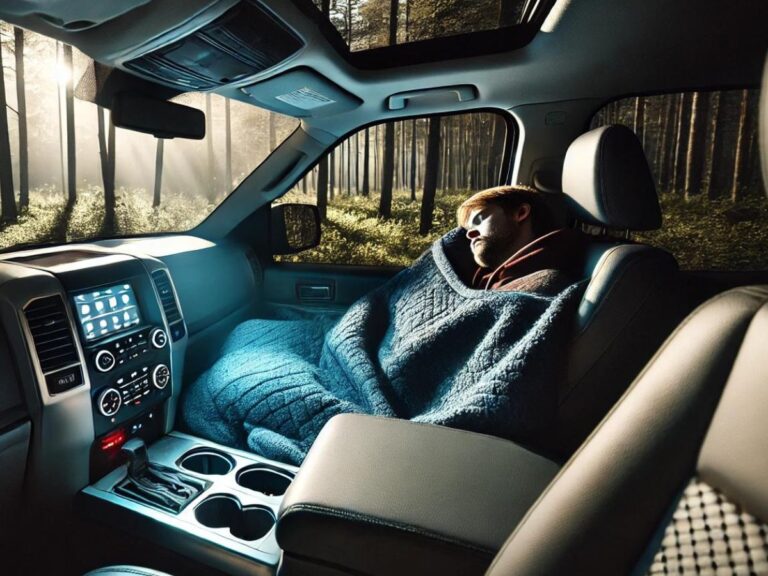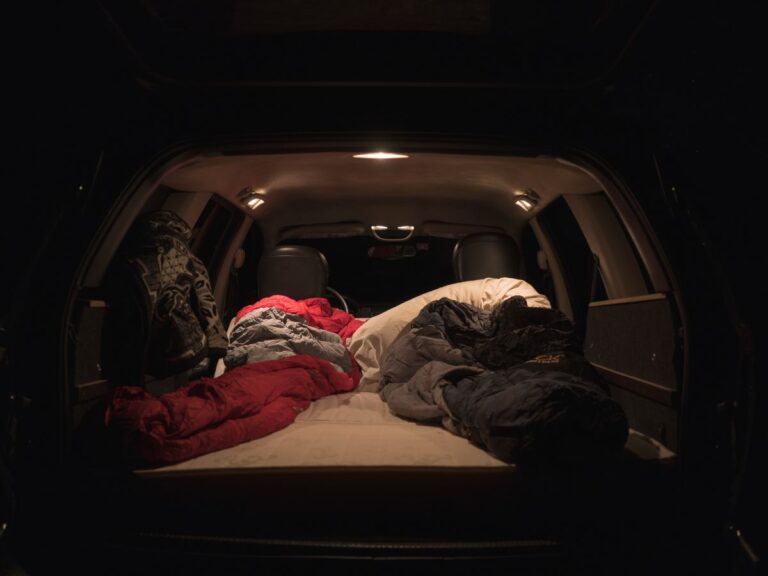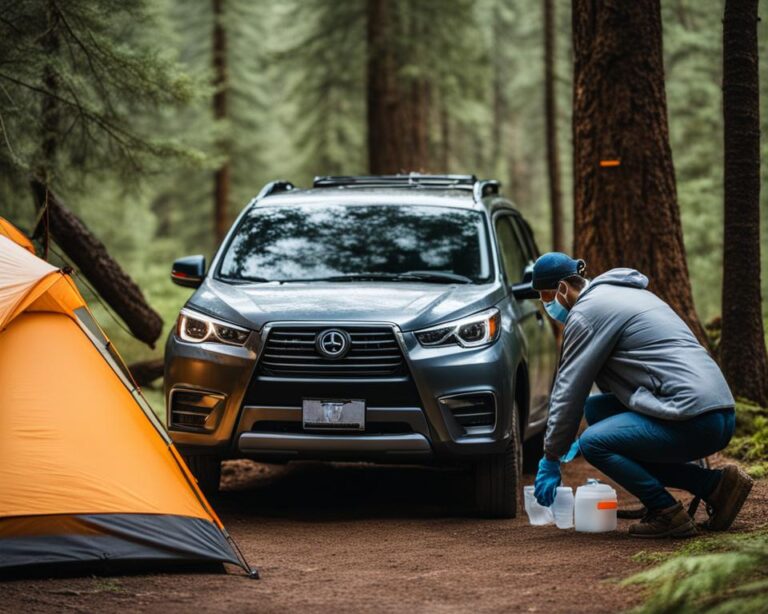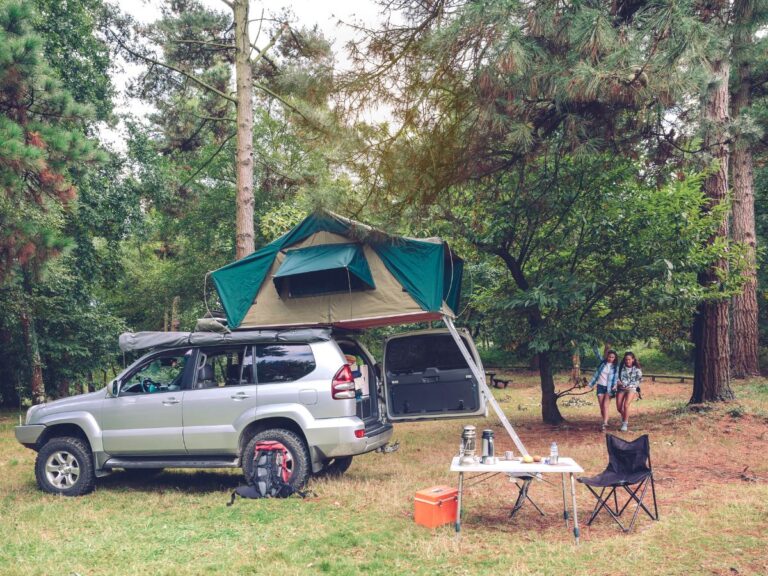Your Comprehensive Guide to Safely Sleeping in Your Car With the Engine off
When you sleep in your car with the engine off, choose well-lit and busy spots for safety. Soundproofing for privacy and comfort is crucial. Guarantee proper air circulation and temperature control by cracking windows or using shades. Secure your car with locks and alarms. Organize your space for coziness with bedding and storage solutions. Manage lighting and noise levels with curtains and earplugs. Hygiene essentials like wet wipes are a must. Stay tuned for more helpful tips on location selection, ventilation, security, comfort, privacy, lighting, cleanliness, and noise management while sleeping in your car.
Choosing the Right Location
To ensure a safe night’s rest when sleeping in your car, carefully select a well-lit and populated area with legal parking options. Lighting options play an important role in ensuring your safety. Opt for areas with ample streetlights or well-lit parking lots to deter any potential threats and make it easier for you to monitor your surroundings. Additionally, consider using window covers or curtains for privacy solutions, which can also help regulate the temperature inside your vehicle.
Noise reduction is another essential factor to keep in mind when choosing a suitable location for sleeping in your car. Select areas away from busy roads, highways, or other sources of loud disturbances to minimize disruptions to your sleep. Look for spots with natural barriers like trees or buildings that can act as sound buffers.
Moreover, when deciding on a location, prioritize places that are frequented by other people, such as rest areas or designated parking spots for overnight stays. This not only enhances your safety but also provides a sense of security knowing that help is nearby if needed.
Ensuring Adequate Ventilation
When selecting a suitable location for sleeping in your car, it is essential to guarantee adequate ventilation within the vehicle to maintain a comfortable and safe environment. To make sure proper air circulation while sleeping in your car, consider slightly cracking open a window. This small opening can greatly improve ventilation and prevent the buildup of stale air inside the vehicle.
Another effective way to enhance ventilation is by utilizing a roof vent if your car is equipped with one. Roof vents help in bringing fresh air into the vehicle while expelling warm or stale air, creating a more pleasant sleeping environment.
Remember that adequate ventilation is key to preventing condensation, reducing stuffiness, and ensuring a continuous flow of fresh air throughout the night. By implementing these simple strategies, you can optimize the airflow within your car, promoting a restful and safe sleep experience.
Securing Your Belongings
Ensuring the security of your belongings while sleeping in your car is essential to safeguarding your personal items and maintaining a sense of safety and order within the vehicle. To protect your valuables, consider installing locking mechanisms on compartments where you store important items. Secure any hidden storage areas within your car to prevent theft. Make sure to stow away personal items such as electronics, wallets, and keys in these secure spaces before settling down for the night. Avoid leaving any valuable possessions in plain sight, as this can attract unwanted attention. Additionally, it’s advisable to keep your windows closed and doors locked to enhance theft prevention measures. If your car has an alarm system, activate it before going to sleep to further deter potential intruders. By taking these precautions and utilizing available security features, you can rest assured that your belongings are well-protected while you sleep in your car.
Setting Up Comfortably
Securely storing your personal items is the foundation for setting up a comfortable sleeping arrangement in your car. When considering bedding options, choose materials that provide adequate insulation and cushioning, such as memory foam mattress toppers or sleeping bags rated for cold weather. Guarantee your bedding fits the size of your car to maximize comfort and space efficiency.
For storage solutions, utilize organizers like hanging shoe racks or collapsible bins to keep your belongings tidy and easily accessible. Consider installing hooks or nets to secure items in place while you rest. Keeping your car clutter-free not only enhances safety but also contributes to a more relaxing environment.
Comfort essentials like travel pillows, blankets, and window shades can notably improve your sleep quality. Opt for lightweight and breathable materials to regulate temperature and ensure a cozy atmosphere. Additionally, organization tips such as using multi-pocket organizers for small items and creating designated spaces for different categories of belongings can streamline your setup and enhance your overall comfort while sleeping in your car.
Privacy Measures
To enhance privacy while sleeping in your car, consider utilizing window covers or curtains that effectively block out external visibility. Window covers come in various styles such as custom-fit shades or universal sunshades that can be easily attached to your car windows. Curtains, on the other hand, offer a more essential option as they can be tailored to fit your specific vehicle windows.
Soundproofing and insulation are also vital elements for maintaining privacy while sleeping in your car. Soundproofing materials like foam insulation or sound deadening mats can help reduce outside noise entering your vehicle, providing a more peaceful sleeping environment. Additionally, proper insulation can help regulate the temperature inside your car, ensuring a comfortable sleep regardless of the weather outside.
Safety Precautions
When selecting a secure parking location for sleeping in your car, prioritize well-lit areas with surveillance cameras to minimize the risk of break-ins. Guarantee proper ventilation and fresh air circulation inside your vehicle by cracking windows slightly or using a sunroof if available. Additionally, always be prepared for emergencies by keeping essential items like a flashlight, first aid kit, and emergency contact information easily accessible.
Secure Parking Locations
For essential safety while sleeping in your car, it is crucial to carefully select parking locations that are well-lit, populated, and preferably monitored by security personnel. When choosing where to park for the night, consider the following:
- Well-Lit Areas: Opt for parking spots that are well illuminated to deter any potential threats and to help you see your surroundings clearly.
- Populated Locations: Parking in areas with a decent amount of people around can provide an added layer of security and decrease the chances of unwanted attention.
- Security Personnel: Look for parking lots or areas that have security patrols or personnel on-site to enhance safety measures.
- Avoid Hidden Spots: Stay away from secluded or hidden spots that may make you an easy target for criminal activities.
- Prefer Public Lots: Select public lots over remote areas, as they tend to have more visibility and foot traffic, reducing the risk of being isolated.
Ventilation and Fresh Air
Adequate ventilation and access to fresh air are essential safety precautions to prioritize when planning to sleep in your car. Proper ventilation helps prevent the buildup of harmful gases like carbon monoxide, ensuring a safe sleeping environment. Utilizing window covers can help regulate airflow while maintaining privacy. Consider using mesh screens on windows to keep insects out while allowing air circulation.
To maximize ventilation, aim for cross ventilation by opening windows on opposite sides of the car. This technique allows for a steady flow of fresh air throughout the vehicle, reducing stuffiness and ensuring a continuous oxygen supply. Avoid completely sealing the car, even in cold weather, as it can lead to poor air quality and potential health risks.
Regularly check that all windows are securely closed when parked in unfamiliar or isolated locations to prevent unauthorized access. Prioritizing ventilation not only enhances comfort but also plays an important role in creating a safe and healthy sleeping environment in your car.
Emergency Preparedness
Prioritize equipping your car with essential safety measures and supplies to guarantee preparedness for any emergency situation. Having the right emergency supplies and comfort items can make a significant difference in ensuring your safety while sleeping in your car. Here are some key items that should be included in your emergency kit:
- First Aid Kit: Be prepared for minor injuries with a well-stocked first aid kit.
- Emergency Blankets: Stay warm during colder nights with emergency blankets designed for insulation.
- Flashlight and Batteries: Illuminate your surroundings and navigate in the dark with a reliable flashlight and spare batteries.
- Non-Perishable Snacks and Water: Keep yourself nourished and hydrated with non-perishable snacks and water bottles.
- Emergency Contact and Safety Plan: Have a list of emergency contacts and a safety plan in place in case of unforeseen circumstances.
Managing Temperature
Maintain a comfortable temperature inside your car by utilizing window shades to block out excessive sunlight and prevent overheating. During hot weather, consider using reflective or insulating window shades to reduce the greenhouse effect inside your car. These shades can help regulate the internal temperature by minimizing the heat that enters through the windows. Additionally, you can improve temperature control by parking in shaded areas or using a sunshade on the windshield to keep the dashboard and steering wheel from becoming too hot.
In colder climates, insulation options such as thermal curtains or blankets can help retain heat within the car, especially during nighttime when temperatures drop. Insulating the windows and doors can create a barrier against the cold air outside, maintaining a warmer environment inside the vehicle. It’s important to strike a balance with insulation to prevent condensation build-up, which can lead to dampness and discomfort. By carefully managing the temperature inside your car, you can ensure a safe and comfortable sleeping environment while parked.
Lighting Considerations
To ensure a conducive sleeping environment in your car, it’s important to take into account the lighting conditions and how they can impact your comfort and safety during rest periods. Here are some key considerations to help you manage lighting for best sleep in your car:
- Light Sources: Avoid bright overhead lights inside your car. Consider using dimmer lights or small LED lights instead.
- Window Coverings: Use window coverings like sunshades, curtains, or window tint to block out external light sources.
- Sleep Mask: A sleep mask can help block out any remaining light that filters through your window coverings.
- Ambient Lighting: Opt for soft, warm ambient lighting if you need some light inside the car for safety or comfort.
- Adjustable Lighting: Choose lighting options that offer adjustable brightness levels to cater to your specific needs without disturbing your sleep.
Hygiene and Cleanliness
Maintain your car as a sanitary and organized space by implementing effective hygiene practices. Personal grooming is essential when living out of your car. Keep wet wipes, hand sanitizer, and a small mirror handy for daily hygiene routines. Additionally, consider waste disposal; keep a small trash can with a lid to discard used items properly and prevent odors.
Bedding options play an important role in maintaining cleanliness. Opt for bedding that is easy to wash and dries quickly to prevent mold and mildew. Storage solutions are key to keeping your car tidy. Use bins or organizers to store personal items and prevent clutter. Regularly declutter your car to maintain a clean environment.
Dealing With Noise
To minimize disturbances while sleeping in your car, it is important to address and mitigate noise factors that may impact your rest. Here are some effective strategies to help you deal with noise and guarantee a peaceful sleep:
- Noise Canceling Headphones and Earplugs: Invest in a good pair of noise-canceling headphones or earplugs to block out external sounds effectively.
- White Noise Machine: Consider using a white noise machine to drown out surrounding noises with a consistent, soothing sound.
- Soundproofing Materials: Utilize soundproofing materials such as foam panels or soundproof curtains to reduce noise from outside entering your car.
- Strategic Parking: Park your car in a quiet, secluded area away from busy roads or noisy environments to minimize disturbances.
- Window Covers: Use window covers or curtains to help block external noise and light, creating a more peaceful environment for sleeping.
Waking Up Refreshed
Implementing proper sleep hygiene practices can ensure you wake up feeling refreshed and ready for the day ahead. To guarantee excellent sleep quality while sleeping in your car, consider investing in comfortable bedding such as a supportive mattress pad and cozy blankets. Creating a bedtime routine that includes relaxation techniques like deep breathing or gentle stretches can help signal to your body that it’s time to wind down and prepare for rest.
In the morning, having a structured routine is crucial to help you wake up feeling refreshed. Start by opening the windows for fresh air and natural light to signal to your body that it’s time to wake up. Engage in some light stretching or a short walk to get your blood flowing and energy levels up. Having a simple morning hygiene routine, such as brushing your teeth and washing your face, can also contribute to feeling more awake and ready to tackle the day ahead. By incorporating these practices into your sleeping and morning routine, you can optimize your sleep quality and wake up feeling refreshed even after sleeping in your car.
Steps for Safe and Comfortable Sleep in Your Car with the Engine Off
To sum up, by following the steps outlined in this guide, you can safely and comfortably sleep in your car with the engine off. Remember to choose a safe location, guarantee proper ventilation, secure your belongings, set up for comfort, maintain privacy, consider lighting and hygiene, address noise concerns, and wake up feeling refreshed. With attention to detail and preparation, sleeping in your car can be a safe and viable option for rest while on the road.







